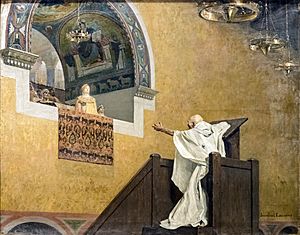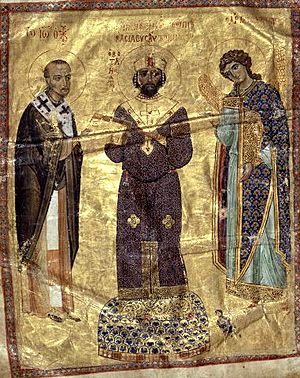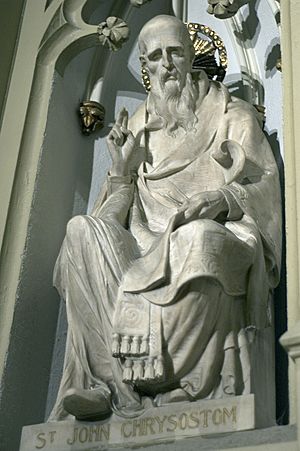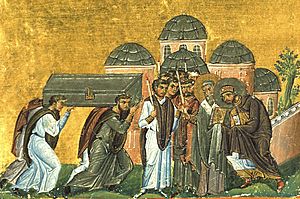John Chrysostom facts for kids
Quick facts for kids SaintJohn Chrysostom |
|
|---|---|

|
|
|
|
| Born | c. 347 Antioch (modern-day Antakya, Hatay, Turkey) |
| Died | 14 September 407 (aged c. 58) Comana in Pontus (region) (modern-day Gümenek, Tokat, Turkey) |
| Venerated in | |
| Canonized | Pre-congregational |
| Feast |
|
| Attributes | Vested as a bishop, holding a Gospel Book or scroll, right hand raised in blessing. He is depicted as emaciated from fasting, with a high forehead, balding with dark hair and a small beard. Symbols: beehive, a white dove, a pan, chalice on a bible, pen and inkhorn |
| Patronage | Constantinople, education, epilepsy, lecturers, public speakers, preachers |
John Chrysostom (born around 347 – died 14 September 407) was an important Early Church Father. He served as the archbishop of Constantinople, a major city in the ancient world. He is famous for his amazing preaching and public speaking. He also spoke out against leaders who misused their power.
His special nickname, Chrysostom, means "golden-mouthed" in Greek. This name shows how skilled he was at speaking. John Chrysostom wrote many books and sermons. He is honored as a saint in many Christian churches today. These include the Eastern Orthodox Church, Catholic Church, and Anglican churches.
In the Eastern Orthodox Church, he is one of the Three Holy Hierarchs. These are three very important church leaders. The other two are Basil the Great and Gregory of Nazianzus.
Biography
John's Early Life
John was born in Antioch in the year 347. His father was a high-ranking military officer. Sadly, John's father died soon after he was born. His mother raised him. He was baptized around 368 or 373.
John started his education with a famous pagan teacher named Libanius. From Libanius, John learned how to be a great speaker. He also developed a love for the Greek language and its literature. He even became a lawyer.
As he grew up, John became more dedicated to Christianity. He studied theology (the study of religious faith) under Diodore of Tarsus. Diodore founded a famous school in Antioch. A Christian historian said that Libanius wished John had followed in his footsteps.
John lived a very strict and simple life. He became a hermit around 375. He spent two years standing almost all the time. He barely slept and memorized the entire Bible. Because of these practices, his health suffered. He had to return to Antioch.
Service in Antioch
John became a deacon in 381. A deacon is a church leader who helps the priest. Later, in 386, he became a presbyter (priest). He worked in Antioch for twelve years. During this time, he became very popular.
He was known for his powerful speeches at the Golden Church, Antioch's main church. He was especially good at explaining parts of the Bible. He also taught about moral living. Many of his important writings come from this time.
John often talked about helping the poor. He cared about both their spiritual and physical needs. His way of explaining the Bible was very direct. He showed people how to apply the Bible's lessons to their daily lives. This made his sermons very popular.
One time, the citizens of Antioch damaged statues of the emperor. The bishop, Flavian, had to ask Emperor Theodosius I for mercy. During this time, John preached many sermons. He asked the people to see their mistakes. His words had a big impact. Many pagans even became Christians. The city was saved from punishment.
Archbishop of Constantinople

In 397, John was chosen to be the archbishop of Constantinople. This was a very important position. He had to leave Antioch secretly. People feared that his departure would cause unrest.
As archbishop, John refused to host fancy parties. This made him popular with ordinary people. But it made him unpopular with rich citizens and other clergy. He also tried to reform the clergy. He told visiting preachers to return to their own churches without extra pay. He also started several hospitals in Constantinople.
His time in Constantinople was difficult. Theophilus, another powerful church leader, opposed John. Theophilus accused John of supporting certain teachings. John also made an enemy of Aelia Eudoxia, the empress. She thought John's sermons about fancy clothes were aimed at her.
Eudoxia and Theophilus held a meeting in 403. They charged John with various things. This led to his removal and banishment. But the people of Constantinople were very upset. They even threatened to burn the imperial palace. The emperor called John back almost immediately. There was also an earthquake, which the empress saw as a sign of God's anger.
But the peace did not last long. A silver statue of Eudoxia was put up near John's church. John spoke out against the dedication ceremony. He called it pagan. He also spoke harshly against the empress. He was banished again, this time to a far-off region. His banishment caused riots. The cathedral was burned down during the fighting.
Around 405, John started supporting Christian monks. These monks were destroying pagan temples and shrines.
Exile and Death
John's banishment was complicated. He wrote to other church leaders for help. Pope Innocent I protested John's banishment. But it did not change anything.
John was sent to a town called Cucusus. Even from exile, his letters had a lot of influence in Constantinople. Because of this, he was exiled even further. He was sent to a place called Pitiunt in modern Georgia. He died on 14 September 407 during the journey. He never reached his final destination.
His last words are said to have been: "Glory be to God for all things."
Veneration and Canonization
John was honored as a saint soon after his death. Thirty years later, his relics (remains) were brought back to Constantinople. They were placed in the Church of the Holy Apostles.
The Eastern Orthodox Church honors him as a "Great Ecumenical Teacher." He is celebrated on several feast days. These include January 27, September 14, and November 13. He is also honored on January 30 with Basil the Great and Gregory the Theologian. In 1908, Pope Pius X named him the patron saint of preachers.
Writings
John Chrysostom wrote many things. About 700 sermons and 246 letters still exist. He also wrote Bible commentaries and other religious books.
Homilies (Sermons)

His most famous sermon is the Paschal Homily. This short sermon is read during the first service of Pascha (Easter) in the Eastern Orthodox Church.
John's sermons are very extensive. He wrote hundreds of sermons on both the New Testament and the Old Testament. Many of his sermons explain books like Genesis, the Psalms, and the Gospel of Matthew.
His sermons were written down by people who listened to him speak. His style was direct and personal. He often spoke about the pagan customs in Constantinople. He criticized popular pagan activities like theater and chariot races.
John also often spoke about the importance of helping those in need. He emphasized giving to charity. He taught that prayer without charity is not complete.
Sermons on Christian Practices
During his early years as a priest in Antioch, John gave a series of sermons. These sermons were for Christians who were taking part in Jewish festivals and other Jewish customs. He wanted to prevent Christians from mixing their faith with these practices. He believed this was pulling them away from their Christian identity.
John said that many Christians, especially women, went to synagogues. They enjoyed the Jewish services and listened to the shofar (a musical instrument). Because of John's importance, his sermons helped to increase the separation between the two communities.
Some scholars say that John's strong language was common for the time. They argue that he was using a style of speaking meant to strongly criticize opposing views.
Other Writings
Besides his sermons, John wrote other important books. One early book was Against Those Who Oppose the Monastic Life. He wrote this for parents whose sons wanted to become monks. He explained that it was common for people in Antioch to send their sons to be educated by monks.
Another important book is On the Priesthood. In this book, he talks about his high view of what it means to be a priest. He also wrote Instructions to Catechumens and On the Incomprehensibility of the Divine Nature. He also wrote letters to a deaconess named Olympias.
Influence on Liturgy
John also had a lasting impact on Christian worship. He helped to organize the prayers and rules for the Divine Liturgy. This is the celebration of the Holy Eucharist. Even today, many Eastern Orthodox and Eastern Catholic Churches use the Divine Liturgy of Saint John Chrysostom.
Legacy and Influence

John lived at a time when many city clergy were criticized for their fancy lifestyles. He tried to reform the clergy in Constantinople. These efforts were difficult and had limited success. He was an excellent preacher. His sermons and writings are still studied today.
He is very important in Eastern Christianity. He is considered one of the Three Holy Hierarchs. His writings have survived more than those of many other early Greek church leaders.
Influence on Church Teachings
John's ideas are found throughout the current Catechism of the Catholic Church. This book explains the teachings of the Catholic Church.
Many Christian leaders praise John. They call him one of the most eloquent preachers ever. One leader described him as a "bright, cheerful, gentle soul."
Music and Literature
John's influence on worship has inspired many musical pieces. Composers like Sergei Rachmaninoff and Pyotr Tchaikovsky wrote music based on his Liturgy.
He is also mentioned in literature. In James Joyce's novel Ulysses, a character is called "Chrysostomos." This is because of his "golden-mouthed" speaking ability.
Relics

John Chrysostom died in 407. His relics stayed there until 438. Then, they were moved to Constantinople.
Most of John's relics were taken from Constantinople by crusaders in 1204. They were taken to Rome. But some of his bones were returned to the Orthodox Church in 2004 by Pope John Paul II. Since then, they have been kept in the Church of St. George, Istanbul.
His skull was kept at a monastery in Greece. In 1655, it was taken to Russia. Today, both the monastery in Greece and some places in Italy claim to have his skull. Other smaller relics are found around the world.
Collected Works
John Chrysostom's works are available in many languages. These include Greek, Latin, English, and French. Many of his writings can be found in large collections. An online list of studies about John Chrysostom is also available.
See also
 In Spanish: Juan Crisóstomo para niños
In Spanish: Juan Crisóstomo para niños
- Saint John Chrysostom, patron saint archive



